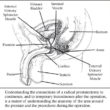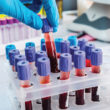Hormonal Therapy Explained
Dr. Catalona has written articles and answered questions on the topic of hormonal therapy in previous issues of Quest, but recent studies have provided new information. This article updates material previously in Quest on the topic of hormonal therapy. The following article contains a good deal of technical information, but we feel the information is helpful and would be of interest to many of our QUEST readers.
Uses of Hormonal Therapy ![]()
Hormonal therapy, sometimes called androgen-deprivation therapy, is prescribed, most commonly, after both a radical prostatectomy and radiation have failed, especially for the treatment of patients with metastases.
In addition patients who are too old, too ill, or those refusing definitive local therapy are sometimes treated primarily with hormonal therapy.
Also, hormonal therapy is often used as an auxiliary treatment in combination with radiation therapy (before, during, and for a period of 6 months to 2 years after) for high-risk (high Gleason Grade and/or high PSA) patients.
The belief is that it enhances the effectiveness of radiation therapy either by reducing the number of cancer cells that have to be killed by radiotherapy or by making the cancer cells more sensitive to radiation or both.
In addition, hormonal therapy is used to treat some patients who have had biochemical (PSA) failure (with or without metastases) after surgery or after radiation therapy.
Sometimes, however, hormonal therapy is used as a primary therapy in older patients who would not tolerate surgery or radiation.
The benefits of hormonal therapy are that it delays cancer progression, reduces symptoms (pain) of metastatic disease, makes radiation therapy more likely to be successful in high-risk patients with local or regional disease, and may increase overall survival in patients with lymph node metastases.
The biologic basis of hormonal therapy is that almost all prostate cancer cells express receptors for male hormones (androgen). Androgen stimulates the growth of prostate cancer cells.
Stopping or slowing down the production of male hormones can slow down or stop the growth of prostate cancer cells, at least for a period of time that is not predictable at the present.
Hormonal therapy can be divided into two phases: primary and secondary.
Primary Hormonal Therapy
Most prostate cancer cells either die or go into a dormant phase when the blood level of the male hormone, called testosterone, and its far more potent derivative, called dihydrotestostrone, are dramatically lowered.
This phase of so-called “androgen-dependent” prostate cancer can be quite variable, lasting from only a few months to as long as 20 years.
Male hormone levels can be lowered or rendered less effective in various ways.
One method of lowering the testosterone level is by removal of the testicles (called castration or orchiectomy).
Another is by injections of a lutenizing hormone-releasing hormone (LHRH) analog, called Lupron (leuprolide) or Zoladex (goserelin). These injections come in 1,3,4,6, and 12-month preparations.
A third alternative is antiandrogen pills, such as Megace (megestrol), Eulexin (flutamide), Casodex (bicalutamide), Nilandron (nilutamide). These medications block androgen receptors in the tissues. They are also usually used during the initiation of injection therapy to block the testosterone ?flare-up? response that occurs during the first few weeks following the initial injection.
Other primary hormonal therapy methods are by treating with estrogen pills (diethylstilbestrol, estrace), patches, or infusions; by inhibitors of androgen synthesis, such as ketoconazole; or by glucocorticoids (such as prednisone or dexamethasone).
In addition, pills that block the conversion of testosterone to dihydrotestosterone, called finasteride (Proscar) or dutasteride (Avodart), are claimed to have a role in prostate cancer prevention and are sometimes used in hormonal therapy regimens. However, these drugs have weak anticancer effects and are not very effective as single agents in treating prostate cancer.
Secondary Hormonal Therapy
In a second phase of hormonal treatment, the tumor can grow even though the male hormone level is low. During this phase, the tumor cells still can be controlled by discontinuing some drugs that were being taken previously or by switching to a different drug. This administration and withdrawal of hormones is called secondary hormonal therapy.
The principle behind secondary hormonal therapy is that while the patient is taking a hormone (such as bicalutamide) that blocks the growth of the cancer, the cancer cells can mutate or change in a way that actually make the bicalutamide stimulate their growth rather than suppress it.
In this situation, simply stopping the bicalutamide can have a beneficial effect and may lower the PSA for a period of 3 to 9 months in 20% to 50% of cases.
After a while, the PSA will again begin to rise. When this rise occurs, other similar drugs of the antiandrogen family, such as flutamide, nilutamide, or megestrol, may be started, and the PSA may again decrease for a period of time.
If the cancer cells again mutate and become stimulated to grow by the new drug, the new drug may be stopped and again, in some cases, the PSA will again decrease.
In this way, it is sometimes possible to use a variety of drugs, switching from one to another, to achieve an additional response. (Megestrol acetate should be avoided in patients with heart disease, high blood pressure, or diabetes.)
When antiandrogen drugs no longer work, it is possible in some cases, to achieve additional responses with other hormonal agents, such as ketoconazole, Stilphostrol (diethylstilbesterol diphosphate), or estrogens. (Some of these drugs, such as ketoconazole require the additional use of cortisone-like medications, because they suppress the production of cortisol by the adrenal glands.)
Controversies
Hormonal therapy for prostate cancer has its controversies.
One is whether a combined blockade of male hormones from the testicles and those from the adrenal glands is better than just initially blocking only the hormones from the testicles. Hormones from the testicles are responsible for more than 90% of male hormones in the body.
Little evidence suggests that combined blockade is more effective. Also, adverse side effects are more common with combined blockade, and any advantage must be balanced against the potential for increased side effects and the greater expense.
Another area of controversy is related to the timing of treatment, i.e., whether hormonal therapy should be given before there are metastases or symptoms. Several studies have shown no advantage for early hormonal therapy; however, one has shown a survival advantage for early treatment in men with lymph node metastases.
Another area of controversy relates to intermittent versus continuous hormonal therapy. The advantage of intermittent hormonal therapy is that it gives the patient ?holidays? to recover from the adverse side effects of continuous hormonal therapy.
The great majority of patients respond to intermittent hormonal therapy. Some studies have demonstrated equivalence or a slight advantage for intermittent therapy; however, until larger clinical trials have been completed, intermittent hormonal therapy is still considered somewhat experimental.
My recommendations for intermittent hormonal therapy are as follows: First, I do not think it is advisable for highly aggressive cancer (Gleason 8-10, high PSA velocity). In other cases, I recommend beginning intermittent hormonal therapy with bicalutamide 50 mg daily for 10 days (1 day before and 9 days after the 3 or 4 month Lupron or Zoladex injection. Then, I recommend measuring the PSA every 3 months. The PSA level usually falls to near zero. I recommend repeating the treatment when PSA rises to 4 ng/ml.
Antiandrogen Monotherapy with High-Dose Bicalutamide
Studies have shown that higher doses of bicalutamide are nearly as effective as castration, Lupron or Zoladex. This approach might reduce the risk of osteoporosis, but may be associated with an increased risk for fluid retention, heart failure, and blood clots. Bicalutamide is used by some physicians to delay the risk for cancer progression in an adjuvant setting in high-risk patients but may not benefit low-risk patients and may also expose them to a greater risk for fluid retention and blood clots.
Possible Side Effects of Hormonal Therapy
Possible side effects of hormonal therapy include hot flashes (that can be treated with megestrol acetate or antidepressants like ), osteoporosis and fractures, sexual dysfunction, increased body fat (11%), decreased muscle mass (4%), adverse changes in cholesterol and triglycerides, increased fasting blood glucose and hemoglobin A1c with an increased risk for diabetes, changes in arterial compliance with an increased risk of heart attack, breast enlargement with some medications that have estrogen or progesterone-like properties (this side-effect can be minimized by pre-treatment irradiation of the breasts, tamoxifen, or surgery), dry skin, dry eyes, hair loss, anemia, loss of energy, cognitive dysfunction, depression, and vertigo. Individual drugs have their specific side effects. For instance, flutamide can cause diarrhea and liver dysfunction while nilutamide can cause interstitial pneumonia.
Osteoporosis is common in prostate cancer patients receiving long-term continuous hormonal therapy, especially slender white men, men with positive family history of osteoporosis, and men taking steroids. There is a 5- to 10- fold increase loss of bone during first year of treatment. Dual energy x-ray absorptiometry of the hip is the gold-standard diagnostic test for measuring bone loss.
Smoking and alcohol cessation, weight bearing exercise, vitamin D3 and calcium supplements are also helpful in preventing osteoporosis. Medicines, called bisphosponates, decrease fracture risk and should be used if there is evidence of significant bone loss.
One of the most widely used bisphosphonates is called zoledronic acid. It is given in an intravenous infusion (4 mg every 3 months) for 1 year. Infusions of zoledronic acid are also useful in protecting bone loss. However, zoledronic acid must be used with caution in patients who have had extensive dental work, as it can cause deterioration of the jawbone, called osteonecrosis of the mandible.
My recommendations for intermittent hormonal therapy are as follows: First, I do not think it is advisable for highly aggressive cancer (Gleason 8-10, high PSA velocity). In other cases, I recommend beginning intermittent hormonal therapy with bicalutamide 50 mg daily for 10 days (1 day before and 9 days after the 3 or 4 month Lupron or Zoladex injection. Then, I recommend measuring the PSA every 3 months. The PSA level usually falls to near zero. I recommend repeating the treatment when PSA rises to 4 ng/ml.
Hormone-Resistant Prostate Cancer
Even after prostate cancer cells reach the stage at which they are no longer responsive to hormone therapy, they still may be sensitive to treatment with radiation, chemotherapy or experimental drugs.
The great majority of patients do not develop symptoms of metastatic prostate cancer (such as pain or weight loss) until the PSA has reached a level of 100 to 300. Some patients with very advanced disease have PSA levels in the thousands.
Each tumor is somewhat unique in its behavior, as is each patient. Measurement of PSA levels is the best way of determining the response of therapy.
In general, if the PSA level can be decreased by 50%, survival is usually prolonged.
Chemotherapy
Significant responses can be achieved with chemotherapy, although, in general, chemotherapy is less effective and has more side effects than primary hormonal therapy. However, some regimens are very well tolerated and offer reasonable prospects for benefit.
Recently docetaxel has been combined with a glucocorticoid (dexamethasone, prednisone, or hydrocortisone) for men with hormone-refractory prostate cancer. One regimen combines these drugs with thalidomide, which works as an agent that blocks the growth of blood vessels that feed the tumor.
Spot radiation therapy can be effective in reducing pain from bone metastases and protects against the development of pathologic fractures, fractures that occur because the bone dissolves away because of the hormone treatments or is eaten away by the cancer.
The goals in treating advanced prostate cancer are to maintain a high quality of life, relieve symptoms, and prolong survival. These goals can require the use of other medications such as nonsteroidal anti-inflammatory agents as well as stronger narcotic medications.
Several new drugs and approaches are under investigation. Further research will certainly bring new and more effective treatments for hormone-refractory prostate cancer, advanced prostate cancer that no longer responds to treatment with hormones.











